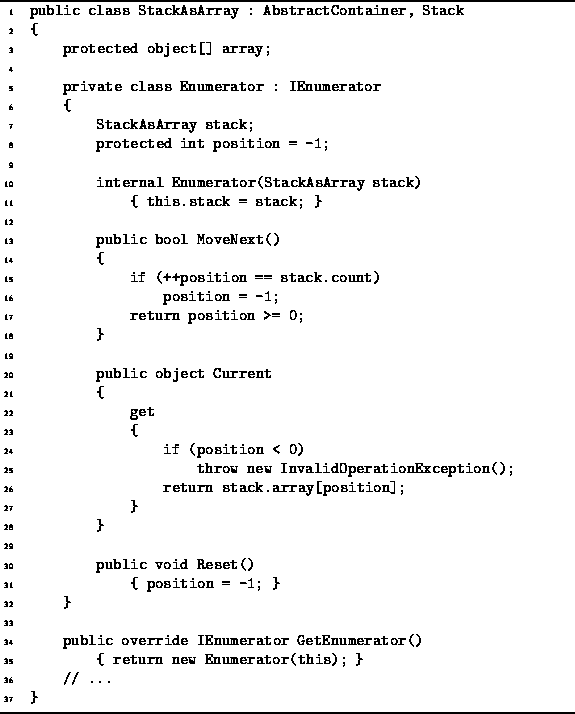|
Data Structures and Algorithms
with Object-Oriented Design Patterns in C# |
As discussed in Section ![]() ,
the GetEnumerator method of a Container
returns an IEnumerator.
An enumerator is meant to be used like this:
,
the GetEnumerator method of a Container
returns an IEnumerator.
An enumerator is meant to be used like this:
Stack stack = new StackAsArray(57);
stack.Push(3);
stack.Push(1);
stack.Push(4);
IEnumerator e = stack.GetEnumerator();
while (e.MoveNext())
{
Object obj = e.Current;
Console.WriteLine(obj);
}
This code creates an instance of the StackAsArray class
and assigns it to the variable stack.
Next, several ints are pushed onto the stack.
Finally, an enumerator is used to systematically print out all
of the objects in the stack.
Program ![]() defines GetEnumerator method
of the StackAsArray class.
The GetEnumerator method returns a new instance
of the private class StackAsArray.Enumerator
that implements the IEnumerator interface (lines 5-32).
defines GetEnumerator method
of the StackAsArray class.
The GetEnumerator method returns a new instance
of the private class StackAsArray.Enumerator
that implements the IEnumerator interface (lines 5-32).

Program: StackAsArray class GetEnumerator method.
The Enumerator class has two fields, stack and position. The stack field refers to the stack whose elements are being enumerated. The position field is used to keep track of the position in the array of the current object.
The MoveNext method is called in the loop termination test of the while loop given above. The purpose of MoveNext method is to advance the enumerator to the next object in the stack. The enumerator resets the position to -1 and returns false when there are no more elements. Clearly, the running time of MoveNext is O(1).
The Current property provides a get accessor that returns the current object. It returns the object in the stack specified by the position field provided that the value of the position field is non-negative. Otherwise, it throws a InvalidOperationException exception. Clearly, the running time of Current is also O(1).